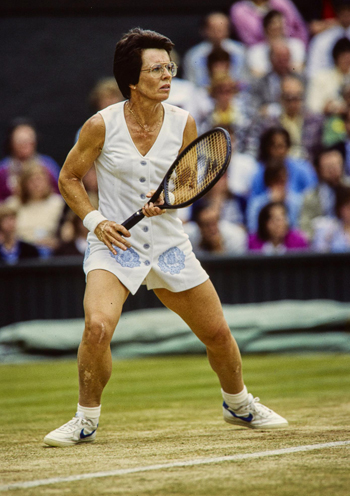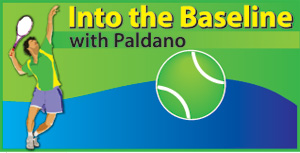Professional tennis chapter
ILTA, that is the present ITF, debarred professional from participation in tennis events until late 1960s, such was the tennis tradition. During that period, men’s professional tennis was making little money, sometimes little as -/25 dollar cents for every point won, playing in make shift venues. Women had to retire.

Billy Jean King
Billie Jean [Mofitt] King, winner of multiple Grand Slam lady’s titles took this issue seriously when her career finished in the late 60s. In the middle of the ‘women’s lib’ era, King lead the tennis revolution and took 1$ from Gladys Heldman, publisher of the magazine World Tennis, along with fellow players Rosie Casal, Nancy Richy, Julie Heldman and six others to defy the system. Known as the original nine, they played the Virginia Slims event in Florida. With that WTA professional body came to being in early 1970s. It was the product of the one-dollar revolution by Billie Jean King.
Professional history
Tennis, appeared alongside croquet and lawn bowling in England as another social sport with royal patronage in the mid-1800. Largely due to the technological achievement in rubber vulcanising process by Dunlop. A light weight air filled ball that bounced came to being cheap and freely available to play tennis. This made tennis another social sport in Europe, which until then was played exclusively in the European royal courts. Amateurism was severely adhered to in tennis. Leaving full time elite players paupers at the end of their competition career. As a practice, all the leading amateurs who turned professionals until late 1960s played among themselves for money. They were not allowed into tennis clubs. One of the founders of ATP, Cliff Drysdale held an event in his native South Africa, in a car park. This is the humble history of the rich ATP tennis of today.
When men and women came under the umbrella of professionalism in the 1973 and permitted to play under the banner Ópen Tennis, the proportion of payment for men is to women was 12:1. This lead to the breakaway of the women’s tennis from that of men. Since 1973 WTA has been a separate entity. With equal pay being the order of the day now, leading players are mediating to make WTA and ATP into a single entity. The Grand Slams and in few other events both genders play together. The observation is, playing together has more audience appeal than separately. It is likely to happen when the present situation improves.
Billie Jean King
Better known as Billie Jean, is still active in tennis administration and promotions. Stadiums, courts and trophies are named after her in USA. Her advice to players is to get onto the court with head, heart and guts. She said this in a recent interview. Billie Jean played an all court game, most effective at net. King’s post career life was devoted to WTA creation and administration.
Women’s Tennis Association [WTA] has over 2500 in membership. Their elite ranking has been brought down to effective 750. The rationale behind that is, no player ranked below 750 can make a living playing tennis. There are provisions to play entry level WTA events with national and ITF ranking.
National/regional administration
Ever since the professional bodies began to control global events, national and regional controlling bodies role in tennis has been diminished. For the national controlling bodies, it is about sustaining the game in the country. The tennis court availability to play is alarmingly reduced in many countries. Most of the city courts that were there 20 years ago are closed and the few available are utilised by coaching profession exclusively for groups.
A player after reaching tournament levels, need to play about 10 singles sets a week minimum and another half that number in doubles to progress. Additionally, recreational social players need the court in the cooler part of the evening. Many local administrations miss out in these aspect. These are the aspects that make the game of tennis appealing in a country.
In most of the developing countries their local top ranked players will not gain entry into professional events. These inlet events do not need high end tennis but the possession of well-versed game, which is a product of regular match play practice and not regular coaching sessions. Our record with WTA is better than ATP, but both are at lower levels.
Tennis 2021 – ???????
 The severe third wave of the coronavirus has left us with all hopes pinned onto the vaccine. Luckily a few have surfaced. All wait for the good effects of the vaccine and its administration. Right now the number of infected is nearing one percent of the known world population; 80 million. In 2021 tennis will have to navigate in this situation. Many of the global events have been stopped. Australia and Asia countries are the main arenas in the early part of the year in tennis. None are willing to risk the improving situation they have now.
The severe third wave of the coronavirus has left us with all hopes pinned onto the vaccine. Luckily a few have surfaced. All wait for the good effects of the vaccine and its administration. Right now the number of infected is nearing one percent of the known world population; 80 million. In 2021 tennis will have to navigate in this situation. Many of the global events have been stopped. Australia and Asia countries are the main arenas in the early part of the year in tennis. None are willing to risk the improving situation they have now.
The hopes of having the early tennis events in January to March does not look good. Experts say it would take very long time to normalise the present situation. Only after that a viable time frame could be stated.
Season’s greetings to all.
—George Paldano, Former int. player; Accredited Coach of German Tennis Federation; National coach Brunei and Sri Lanka, coached ATP, WTA and ITF top 200 ranked players, Davis-Cup, Federation-Cup coach. ———- geodano2015@gmail.com


